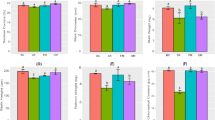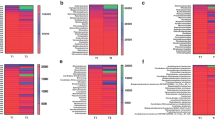Abstract
Purpose
The extract of Stevia residue is an ideal substitute for cultivation of the purple nonsulfur bacterium, like Rhodopseudomonas palustris (R. palustris). But the influence of R. palustris grown under residue extract on its downstream application is still not well-characterized. The objective of this study was to assess the effect of foliar spray of R. palustris grown under Stevia residue extract on the plant growth and soil microbial properties.
Materials and methods
A pot experiment was carried out under the greenhouse condition, consisting of four treatments varying in the sprayed substances: sterilized water (control), R. palustris grown under the chemical medium supplemented with L-tryptophan (SyT), R. palustris grown under Stevia residue extract supplemented with L-tryptophan (ExT), and R. palustris grown under Stevia residue extract supplemented with NH4Cl (ExT). The net photosynthesis rate of the uppermost leaves was measured with a portable photosynthesis system. Soil microbial activity was analyzed by microcalorimetry. Soil bacterial community components were determined by real-time quantitative PCR (qPCR) and high-throughput sequencing techniques.
Results and discussion
Compared with SyT, the R. palustris grown under Stevia residue extract not only improved the plant biomass and the net photosynthetic rate to a large extent, but also increased soil microbial metabolic activity and altered community compositions as well. The treatments receiving R. palustris, especially ExT and ExN, increased the relative abundances of some functional guilds involved in C turnover and nutrient cycling in soil, including Acidobacteria, Actinobacteria, Proteobacteria, Gemmatimonadaetes, Nitrospirae, and Planctomycetes.
Conclusions
R. palustris grown under the Stevia residue extract showed advantages over that under the chemical medium on both plant growth and soil microbial properties. One of the possible reasons could result from the increases in microbial activity and several bacterial keystone guilds involved into C and nutrient cycling, both of which potentially contribute to the improved plant growth. The results would be conducive to the downstream application of R. palustris in an economical way.



Similar content being viewed by others
References
Acosta-Martinez V, Dowd S, Sun Y, Allen V (2008) Tag-encoded pyrosequencing analysis of bacterial diversity in a single soil type as affected by management and land use. Soil Biol Biochem 40(11):2762–2770
Atamna-Ismaeel N, Finkel OM, Glaser F, Sharon I, Schneider R, Post AF, Spudich JL, von Mering C, Vorholt JA, Iluz D, Beja O, Belkin S (2012) Microbial rhodopsins on leaf surfaces of terrestrial plants. Environ Microbiol 14(1):140–146
Attard E, Poly F, Commeaux C, Laurent F, Terada A, Smets BF, Recous S, Le Roux X (2010) Shifts between Nitrospira- and Nitrobacter-like nitrite oxidizers underlie the response of soil potential nitrite oxidation to changes in tillage practices. Environ Microbiol 12(2):315–326
Bais H, Weir T, Perry L, Gilroy S, Vivanco J (2006) The role of root exudates in rhizosphere interactions with plants and other organisms. Annu Rev Plant Biol 57:233–266
Berg G, Ding G-C, Radl V, Schloter-Hai B, Jechalke S, Heuer H, Smalla K, Schloter M (2014) Dynamics of soil bacterial communities in response to repeated application of manure containing sulfadiazine. PLoS One 9(3):e92958
Cai HY, Yan ZS, Wang AJ, Krumholz LR, Jiang HL (2013) Analysis of the attached microbial community on mucilaginous cyanobacterial aggregates in the eutrophic Lake Taihu reveals the importance of Planctomycetes. Microb Ecol 66(1):73–83
Chaudhry V, Rehman A, Mishra A, Chauhan PS, Nautiyal CS (2012) Changes in bacterial community structure of agricultural land due to long-term organic and chemical amendments. Microb Ecol 64(2):450–460
Coenye T, Vandamme P (2003) Diversity and significance of Burkholderia species occupying diverse ecological niches. Environ Microbiol 5(9):719–729
Estrada-De los Santos P, Bustillos-Cristales R, Caballero-Mellado J (2001) Burkholderia, a genus rich in plant-associated nitrogen fixers with wide environmental and geographic distribution. Appl Environ Microbiol 67(6):2790–2798
Fuerst JA, Sagulenko E (2011) Beyond the bacterium: planctomycetes challenge our concepts of microbial structure and function. Nat Rev Microbiol 9(6):403–413
Gyaneshwar P, Hirsch AM, Moulin L, Chen WM, Elliott GN, Bontemps C, Estrada-de los Santos P, Gross E, dos Reis FB, Sprent JI, Young JPW, James EK (2011) Legume-nodulating Betaproteobacteria: diversity, host range, and future prospects. Mol Plant Microbe In 24(11):1276–1288
Harada N, Nishiyama M, Otsuka S, Matsumoto S (2005) Effects of inoculation of phototrophic purple bacteria on grain yield of rice and nitrogenase activity of paddy soil in a pot experiment. Soil Sci Plant Nutr 51(3):361–367
Hotta Y, Tanaka T, Takaoka H, Takeuchi Y, Konnai M (1997) Promotive effects of 5-aminolevulinic acid on the yield of several crops. Plant Growth Regul 22:109–114
Hu J, Lin X, Wang J, Dai J, Chen R, Zhang J, Wong M (2010) Microbial functional diversity, metabolic quotient, and invertase activity of a sandy loam soil as affected by long-term application of organic amendment and mineral fertilizer. J Soils Sediments 11(2):271–280
Hu CW, Chang YL, Chen SJ, Kuo-Huang LL, Liao JC, Huang HC, Juan HF (2011) Revealing the functions of the transketolase enzyme isoforms in Rhodopseudomonas palustris using a systems biology approach. PLoS One 6(12):e28329
Huang X-F, Chaparro JM, Reardon KF, Zhang R, Shen Q, Vivanco JM (2014) Rhizosphere interactions: root exudates, microbes, and microbial communities. Botany 92(4):267–275
Jangid K, Williams MA, Franzluebbers AJ, Sanderlin JS, Reeves JH, Jenkins MB (2008) Relative impacts of land-use, management intensity and fertilization upon soil microbial community structure in agricultural systems. Soil Biol Biochem 40:2843–2853
Kantachote D, Torpee S, Umsakul K (2005) The potential use of anoxygenic phototrophic bacteria for treating latex rubber sheet wastewater. Electron J Biotechn 8(3):314–323
Kim MK, Choi K-M, Yin C-R, Lee K-Y, Im W-T, Lim JH, Lee S-T (2004) Odorous swine wastewater treatment by purple non-sulfur bacteria Rhodopseudomonas palustris, isolated from eutrophicated ponds. Biotechnol Lett 26(10):819–822
Lee KH, Koh RH, Song HG (2008) Enhancement of growth and yield of tomato by Rhodopseudomonas sp under greenhouse conditions. J Microbiol 46(6):641–646
Li X, Shi H, Wang Y, Zhang S, Chu J, Zhang M, Huang M, Zhuang Y (2011) Effects of vitamins (nicotinic acid, vitamin B1 and biotin) on phototrophic hydrogen production by Rhodobacter sphaeroides ZX-5. Int J Hydrogen Energ 36(16):9620–9625
Lindow SE, Brandl MT (2003) Microbiology of the phyllosphere. Appl Environ Microbiol 69:1875–1883
Liu YR, Zheng YM, Zhang LM, He JZ (2014) Linkage between community diversity of sulfate-reducing microorganisms and methylmercury concentration in paddy soil. Environ Sci Pollut Res Int 21(2):1339–1348
Lopes AR, Manaia CM, Nunes OC (2014) Bacterial community variations in an alfalfa-rice rotation system revealed by 16S rRNA gene 454-pyrosequencing. FEMS Microbiol Ecol 87(3):650–663
Oda Y, Larimer FW, Chain PSG, Malfatti S, Shin MV, Vergez LM, Hauser L, Land ML, Braatsch S, Beatty JT, Pelletier DA, Schaefer AL, Harwood CS (2008) Multiple genome sequences reveal adaptations of a phototrophic bacterium to sediment microenvironments. P Natl Acad Sci USA 105(47):18543–18548
Pandey N, Gupta B, Pathak GC (2013) Enhanced yield and nutritional enrichment of seeds of Pisum sativum L. through foliar application of zinc. Sci Hortic 164:474–483
Pascault N, Ranjard L, Kaisermann A, Bachar D, Christen R, Terrat S, Mathieu O, Lévêque J, Mougel C, Henault C, Lemanceau P, Péan M, Boiry S, Fontaine S, Maron P-A (2013) Stimulation of different functional groups of bacteria by various plant residues as a driver of soil priming effect. Ecosystems 16(5):810–822
Pedraza RO, Bellone CH, Carrizo de Bellone S, Boa Sorte PMF, Teixeira KRS (2009) Azospirillum inoculation and nitrogen fertilization effect on grain yield and on the diversity of endophytic bacteria in the phyllosphere of rice rainfed crop. Eur J Soil Biol 45(1):36–43
Penuelas J, Terradas J (2014) The foliar microbiome. Trends Plant Sci 19(5):278–280
Pidot SJ, Coyne S, Kloss F, Hertweck C (2014) Antibiotics from neglected bacterial sources. Int J Med Microbiol 304(1):14–22
Puri M, Sharma D, Tiwari AK (2011) Downstream processing of stevioside and its potential applications. Biotechnol Adv 29(6):781–791
Rampelotto PH, de Siqueira FA, Barboza AD, Roesch LF (2013) Changes in diversity, abundance, and structure of soil bacterial communities in Brazilian Savanna under different land use systems. Microb Ecol 66(3):593–607
Schmidt EW, Obraztsova AY, Davidson SK, Faulkner DJ, Haygood MG (2000) Identification of the antifungal peptide-containing symbiont of the marine sponge Theonella swinhoei as a novel δ-proteobacterium, “Candidatus Entotheonella palauensis”. Mar Biol 136:969–977
Xu J, Feng Y, Wang Y, Lin X (2013a) Characteristics of purple nonsulfur bacteria grown under Stevia residue extractions. Lett Appl Microbiol 57:420–426
Xu J, Feng Y, Wang Y, Wang J, He X, Lin X (2013b) Soil microbial mechanisms of Stevia rebaudiana (Bertoni) residue returning increasing crop yield and quality. Biol Fertil Soils 49(7):839–846
Yin ZP, Shang ZW, Wei C, Ren J, Song XS (2012) Foliar sprays of photosynthetic bacteria improve the growth and anti-oxidative capability on Chinese dwarf cherry seedlings. J Plant Nutr 35(6):840–853
Zhang H, Sekiguchi Y, Hanada S, Hugenholtz P, Kim H, Kamagata Y, Nakamura K (2003) Gemmatimonas aurantiaca gen. nov., sp nov., a gram-negative, aerobic, polyphosphate-accumulating micro-organism, the first cultured representative of the new bacterial phylum Gemmatimonadetes phyl. nov. Int J Syst Evol Micr 53:1155–1163
Zheng S, Hu J, Chen K, Yao J, Yu Z, Lin X (2009) Soil microbial activity measured by microcalorimetry in response to long-term fertilization regimes and available phosphorous on heat evolution. Soil Biol Biochem 41(10):2094–2099
Acknowledgments
This work was supported jointly by the National Natural Science Foundation of China (41501264 and 41571286), the Natural Science Foundation of Jiangsu Province (BK20140991), the Research Fund of State Key Laboratory of Soil and Sustainable Agriculture, Nanjing Institute of Soil Science, Chinese Academy of Science (Y412201441), and the Startup Foundation for Introducing Talent of Nanjing University of Information Science and Technology(NUIST).
Author information
Authors and Affiliations
Corresponding author
Additional information
Responsible editor: Chengrong Chen
Rights and permissions
About this article
Cite this article
Xu, J., Feng, Y., Wang, Y. et al. The foliar spray of Rhodopseudomonas palustris grown under Stevia residue extract promotes plant growth via changing soil microbial community. J Soils Sediments 16, 916–923 (2016). https://doi.org/10.1007/s11368-015-1269-1
Received:
Accepted:
Published:
Issue Date:
DOI: https://doi.org/10.1007/s11368-015-1269-1




